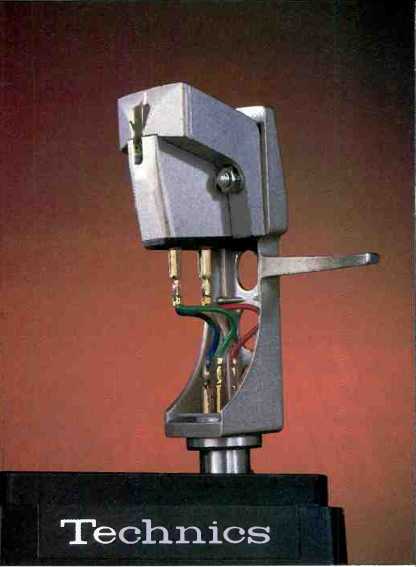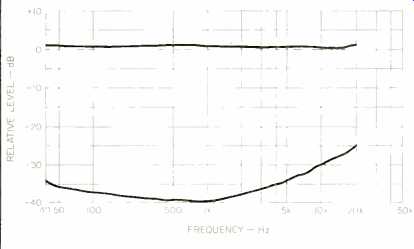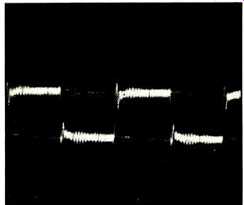
Manufacturer's Specifications:
Cartridge:
Type: Moving-coil, with coreless twin-ring coil.
Cantilever: Tapered pure-boron pipe.
Damper: TTDD (Technics Tempera ture Defense Damper).
Frequency Response: 10 Hz to approximately 10 kHz, ±0.5 dB (frequency range, 5 Hz to approximately 100 kHz).
Temperature Characteristics: 5° C to 35° C, ± 1 dB at 10 kHz; standard: 1 kHz.
Output Voltage: 0.18 mV at 1 kHz at 5 cm/S, zero to peak, lateral velocity; 0.5 mV at 1 kHz at 10 cm/S, zero to peak, 45° velocity, DIN 45-500.
Channel Separation: Greater than 25 dB at 1 kHz; greater than 20 dB at 10 kHz.
Channel Balance: Within 1 dB at 1 kHz.
D.c. Resistance: 25 ohms.
Impedance: 25 ohms at 1 kHz (pure resistance).
Compliance: 12 x 10-6 cm/dyne at 100 Hz.
Vertical Tracking Angle: 20°.
Recommended Stylus Pressure Range: 1.00 to 1.50 grams (10.0 to 15.0 mN).
Stylus Tip: 0.2 x 0.7 mil, elliptical; block diamond.
Weight: 6 grams.
Effective Mass: 0.098 mg.
Mounting Dimensions: 0.5-in. spacing (cartridge already mounted in headshell).
Price: $300.
Transformer:
Type: Step-up, for MC cartridges; amorphous toroidal core.
Recommended Cartridge Impedance: Low, 3-ohm range for load impedances of 10 ohms or less; medium, 15-ohm range for load impedances between 10 and 20 ohms; high, 30-ohm range for load impedances of 20 ohms or more.
Frequency Response: 3 Hz to approximately 300 kHz; 15 Hz to approximately 100 kHz, ±0.2 dB.
THD: No more than 0.001% at 1 kHz.
Channel Separation: Greater than 90 dB at 1 kHz.
Channel Balance: Within 0.2 dB at 1 kHz.
Shielding: Two layers of Permalloy, cast iron, and outer case.
Recommended Load Impedance: 47 kilohms.
Dimensions: 2 3/8 in. W x 3 3/4 in. H x 8 1/4 in. D (6 cm x 9.6 cm x 21 cm).
Weight: 9.9 lbs. (4.5 kg).
Price: $350.
Company Address: One Panasonic Way, Secaucus, N.J. 07094.
To overcome the problem of accurately mounting and properly aligning a phono cartridge in a headshell, Technics markets their top-of-the-line cartridges already mounted in one of their headshells, ready for use after vertical tracking force (VTF) and anti-skating force adjustments have been made.
Some of the outstanding features of the EPC-305MCI I are the pure-boron tapered cantilever tube that is only a few thousandths of an inch in diameter, which accounts for the low effective mass (0.098 mg); the new damping material (TTDD), which is insensitive to temperature (thus making the cartridge very stable), and the use of a high-energy samarium cobalt magnet in the moving-coil cartridge's design.
Because of the very low output from the EPC-305MC11 moving-coil cartridge, it was necessary to design a step-up transformer for it. This special spiral toroidal-core transformer uses amorphous (non-crystalline) magnetic alloy in laminations tens of microns thick. Because of its high saturation characteristics, the spiral toroidal core contributes to wide dynamic range and low distortion in the high range. To achieve a high S/N ratio and prevent hum, the transformer uses four layers of special shielding, which appears to be quite effective since I was unable to induce any hum components in the transformer.
Extreme care must be exercised when mounting the cartridge so as not to bring near it any ferromagnetic (iron, steel, etc.) objects such as screwdrivers or tweezers. These items may unexpectedly be pulled towards the cartridge's powerful magnets and thereby damage the stylus-cantilever assembly.
Like all Technics phono cartridges, the EPC-305MCII comes mounted in a plastic box which also contains the usual assortment of mounting screws, stylus brush, screw driver, and removable stylus guard. Also supplied is a printed frequency response curve which appears, at first glance, to be of a generalized nature, but it is actually a true response curve made by the particular cartridge at hand, according to Technics. The plastic box is packaged in a simple cardboard box. The SH-305MC transformer is packaged in a similar manner.

Measurements
The EPC-305MC11, which comes mounted in its own headshell, was inserted into a Technics EPA-A250 (S shaped) interchangeable tonearm unit attached to a Technics EPA-B500 tonearm base and mounted on a Technics SP-10MKII turntable. The phono cartridge was oriented in the headshell and tonearm with a Dennesen Geometric Soundtracktor.
Where applicable, laboratory measurements of the EPC 305MC11 were made using the Technics SH-305MC step-up transformer. The frequency response of the transformer was measured in the range from 40 Hz to 50 kHz; it was found to be flat from 40 Hz to 40 kHz, and- 0.5 dB at 50 kHz (Fig. 1).
All laboratory tests were conducted at an ambient temperature of 73° F (22.78° C) and a relative humidity of 65%, ±3%. The tracking force for all reported tests was set at 1.25 grams, ± 0.25 gram, with an anti-skating force of 1.5 grams. The EPC-305MC11 cartridge was used with the Technics SH-305MC step-up transformer set to an input impedance of 30 ohms. However, I am of the opinion that the best sound was heard when the transformer's input impedance was set at 15 ohms rather than the suggested 30 ohms. As is my practice, measurements were made on both channels, but only the left channel is reported (unless there is a significant difference between the two channels, in which case both are reported for a given measurement).
The following test records were used in making the reported measurements: CBS STR-100, STR-112, and STR-170; Shure TTR-103, TTR-109, TTR-110, TTR-115, and TTR-117; Deutsches HiFi No. 2; DIN 45-549; Nippon Columbia Audio Technical Record (PCM) XL-7004; B & K OR-2010; Ortofon 0002 and 0003, and JVC TRS-1005 and TRS-1007.
Frequency response, using the CBS STR-170 test record, is + 1.25,-0.0 dB from 40 Hz to 20 kHz. Separation is 41 dB at 1 kHz, 30 dB at 10 kHz, and 26.5 dB at 20 kHz. The data indicates that he EPC-305MCII has excellent response and very good high-frequency separation (Fig. 2).
The 1-kHz square-wave response (Fig. 3) is one of the flattest I have ever seen. The ringing shown was on the test record and was undoubtedly generated by the cutter head when the master was cut. The arm/cartridge low-frequency lateral resonance was 7 kHz. Despite the unusually low lateral resonant frequency, I did not hear any mistracking or distortion at any time.
Using the Dynamic Sound Devices DMA-1 dynamic mass analyzer, I measured the arm/cartridge dynamic mass at 22.5 grams, and the dynamic compliance at 23 x 10-6 cm/dyne at the resonant frequency of 7 Hz. The vertical stylus angle measured 18° for each channel.
Other measured data are: Wt., 6 grams.
D.c. resistance, 21.3 ohms. Opt. tracking force, 1.25 grams.
Opt. anti-skating force, 1.5 grams.
Output, 0.68 mV/cm/S.
IM distortion (200/4000 Hz, 4-to-1): Lateral ( + 9 dB), 1.1%; vertical ( + 6 dB), 1.8%.
Crosstalk (using Shure TTR-109): Left,-32 dB; right, -30 dB.
Channel balance, <0.5 dB.
Trackability: High-freq. (10.8 kHz, pulsed), 30 cm/S; mid-freq. (1000 and 1500 Hz, lateral cut), 31.5 cm/S; low-freq. (400 and 4000 Hz, lateral cut), 24 cm/S.
Increasing the tracking force to 1.5 grams and anti-skating force to 1.7 grams, the low-frequency trackability (400 and 4000 Hz, lateral cut) was 30 cm/S.
The Deutsches HiFi No. 2, 300-Hz test band was tracked cleanly to 86 microns (0.0086 cm) lateral at 16.20 cm/S at + 9.66 dB and to 55.4 microns (0.00554 cm) vertical at 10.32 cm/S at +5.86 dB.
The Technics EPC-305MCII encountered no difficulty in tracking all the test bands on the Shure Era III and Era IV Obstacle Course musical test records as well as level 6 of the Shure Era V trackability disc. Rarely do commercial analog records have peak recorded velocities exceeding 15 cm/S. Therefore, this cartridge would be able to track any commercially available record, including the well-known audiophile recordings issued by Telarc, Sonic Arts, Sheffield, Reference Recordings, RCA Point 5, and Mobile Fidelity Sound Lab.

Fig. 1--Frequency response of the Technics SH-305MC step-up transformer.

Fig. 2--Frequency response (top curve) and separation (bottom curve) of
the EPC-305MCII phono cartridge with SH-305MC transformer.

Fig. 3--Response to a 1-kHz square wave.
Use and Listening Tests
Listening tests are performed both before and after lab oratory measurements. Ail reported listening tests of the Technics EPC-305MC11 were made with the Technics SH EPC-305MC step-up transformer. During the pre-measurement listening evaluation, I was quite impressed with the EPC-305MC11's sonic clarity and transparency of sound, as well as the well-defined and tight bass.
The lack of mistracking and distortion at the resonant frequency of 7 Hz is truly remarkable. I attribute this to the superior design of the Technics EPA-A250 tonearm and, in particular, the super-efficient anti-resonance device that is an integral part of it.
When all the laboratory measurements were completed, it was time for the more serious, final musical evaluation of this moving-coil phono cartridge. As we all know, we listen not to laboratory measurements but to music, and that is the final arbiter in determining how faithfully a phono cartridge does its work. Equipment used in the listening evaluation included the aforementioned Technics tonearm and turntable, an Audio-Technica AT666EX vacuum disc stabilizer, an Amber Model FF 17 preamplifier, two VSP Labs Trans-MOS 150 amplifiers (each used in the 300-watt mono mode), speaker and interconnecting cables from Discrete Technology, and a Technics SL-P10 CD player. The speakers, a pair of B & W 801Fs and a pair of Janis W1 subwoofers with their Interphase 1A units, are located in my specially designed, live end/dead-end listening room.
During the long listening evaluation, I found no coloration present but I did find excellent transient response and tracking ability, and superb applause definition. Stereo imaging and depth were excellent. As was predicted, the EPC-305MC11 reproduced the very high-velocity cannon shots on the Telarc "1812 Overture" (matrix II) record with no apparent difficulty. The human singing voice, the cello, and the Bosendorfer piano were reproduced realistically.
As in the past, I compared an analog record with its CD version, where both had been derived from the same digital master tape. In this case, it was Mussorgsky's "Pictures at an Exhibition" and "Night on Bald Mountain" (Cleveland Orchestra, Maazel, Telarc DG-10042 on vinyl and CD-80042 on CD). Although the EPC-305MC11 reproduced the digital-to-analog vinyl recording very accurately, I feel that there is no contest between the two versions; the CD was superior in every way.
Some of the exceptionally superb recordings I used in auditioning the Technics EPC-305MCII were:
- Magnum Opus, Volume 1 (Wilson Audio W-8111);
- F. I. Tuma's "Stabat Mater" and B. M. Cernohorskys "Choral Works" (Prague Madrigal Singers, S. Janyt, Supraphon 1112 3356);
- Prokofiev's Excerpts from the Ballet, Romeo and Juliet (Los Angeles Philharmonic, Leinsdorf, Sheffield Labs 8);
- Beethoven's "Symphony No. 9" and "Fantasy for Piano, Chorus and Orchestra" (New York Philharmonic, Mehta, RCA Red Seal ARC2-4734, digital);
- David Foster's The Best of Me (Mobile Fidelity Sound Lab MFSL 1-123);
- Wild Bill Davison and Eddie Miller Play Hoagy Carmichael (RealTime Records RT-306, digital);
- Schubert's Four Works for Violin and Piano (Denon 0X7141-ND);
- Ein Straussfest (Cincinnati Pops Orchestra, Kunzel, Telarc digital vinyl DG-10098 and Compact Disc CD-80098); and
- Stravinsky's "L'Histoire du Soldat" and Rimsky-Korsakov's "Capriccio Espagnol" (Chicago Pro Musica, Reference Recordings RR-17).
After evaluating the Technics EPC-305MC11 moving-coil phono cartridge and its SH-305MC step-up transformer over a long period of time, I find that the combination compares very favorably to my moving-coil laboratory reference standard, the Ortofon WC 2000, used with the Electrocompaniet MC-2 pre-preamplifier. Accordingly, if you can't afford the rather expensive but superb Ortofon MC 2000, then I suggest that serious consideration be given to its near-equal, the Technics EPC-305MCII, a truly superior moving-coil phono cartridge.
-B. V. Pisha
(Source: Audio magazine, Aug. 1986)
Also see:
Technics EPC-205CMk4 Cartridge (Jan. 1986)
Technics SP-10MK3 Turntable (Feb. 1985)
= = = =